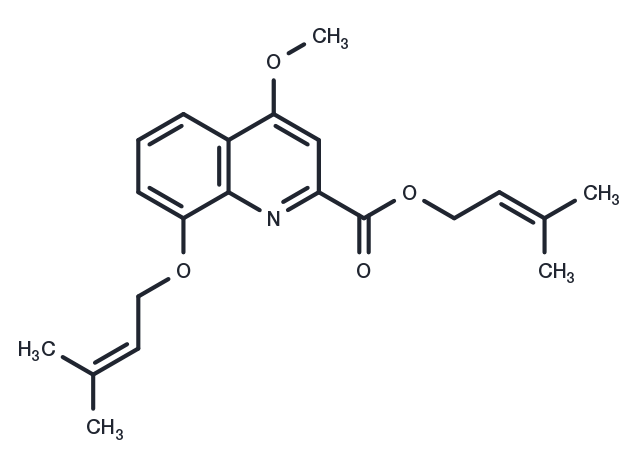Powder: -20°C for 3 years | In solvent: -80°C for 1 year


Ppc-1 is a chemical compound known for its inhibitory effects on the Gram-negative periodontopathogen Porphyromonas gingivalis. It acts as a mitochondrial uncoupler, enhancing mitochondrial oxygen consumption without affecting ATP production. Additionally, Ppc-1 serves as a cell-permeate inhibitor of interleukin-2 (IL-2). This compound exhibits various beneficial activities, including anti-obesity, antibacterial, and anti-inflammatory properties.

| Pack Size | Availability | Price/USD | Quantity |
|---|---|---|---|
| 25 mg | 6-8 weeks | $ 1,520.00 | |
| 50 mg | 6-8 weeks | $ 1,980.00 | |
| 100 mg | 6-8 weeks | $ 2,500.00 |
| Description | Ppc-1 is a chemical compound known for its inhibitory effects on the Gram-negative periodontopathogen Porphyromonas gingivalis. It acts as a mitochondrial uncoupler, enhancing mitochondrial oxygen consumption without affecting ATP production. Additionally, Ppc-1 serves as a cell-permeate inhibitor of interleukin-2 (IL-2). This compound exhibits various beneficial activities, including anti-obesity, antibacterial, and anti-inflammatory properties. |
| In vitro | Ppc-1 inhibits the growth of K562 cells (EC50: 13 μM). Ppc-1 displays about 50% inhibition at 15 μM in all cell lines. Ppc-1 has antiproliferative activities in K562 human leukemia, Hela cervical carcinoma, and 3T3-L1 mouse embryonic fibroblast cells. Ppc-1 treatment (0-10 μM; 24 hours; Jurkat cells) significant inhibits IL-2 production in Jurkat cells (IC50: 4 μM). Using the U937-3xκB-LUC human monocytic cell line, Ppc-1 dose-dependently inhibits the lipopolysaccharide-induced NF-κB activation[2][3][4]. |
| In vivo | Ppc-1 distributes into various tissues of individual animals at low levels after a single administration. Ppc-1 stimulates adipocytes in culture to release fatty acids, which might explain the elevated serum fatty acids in Ppc-1-treated mice. Ppc-1 (0-10 mg /kg; Intraperitoneal injection; once a week; for 8 weeks; female ICR mice) treatment inhibits weight gain with no abnormal effects on liver or kidney tissues, and no evidence of tumor formation. Serum fatty acid levels are significantly elevated in mice treated with Ppc-1, while body fat content remained low [1]. |
| Molecular Weight | 355.43 |
| Formula | C21H25NO4 |
| CAS No. | 1245818-17-0 |
Powder: -20°C for 3 years | In solvent: -80°C for 1 year
You can also refer to dose conversion for different animals. More
bottom
Please see Inhibitor Handling Instructions for more frequently ask questions. Topics include: how to prepare stock solutions, how to store products, and cautions on cell-based assays & animal experiments, etc.
Ppc-1 1245818-17-0 Others Ppc1 Ppc 1 inhibitor inhibit
